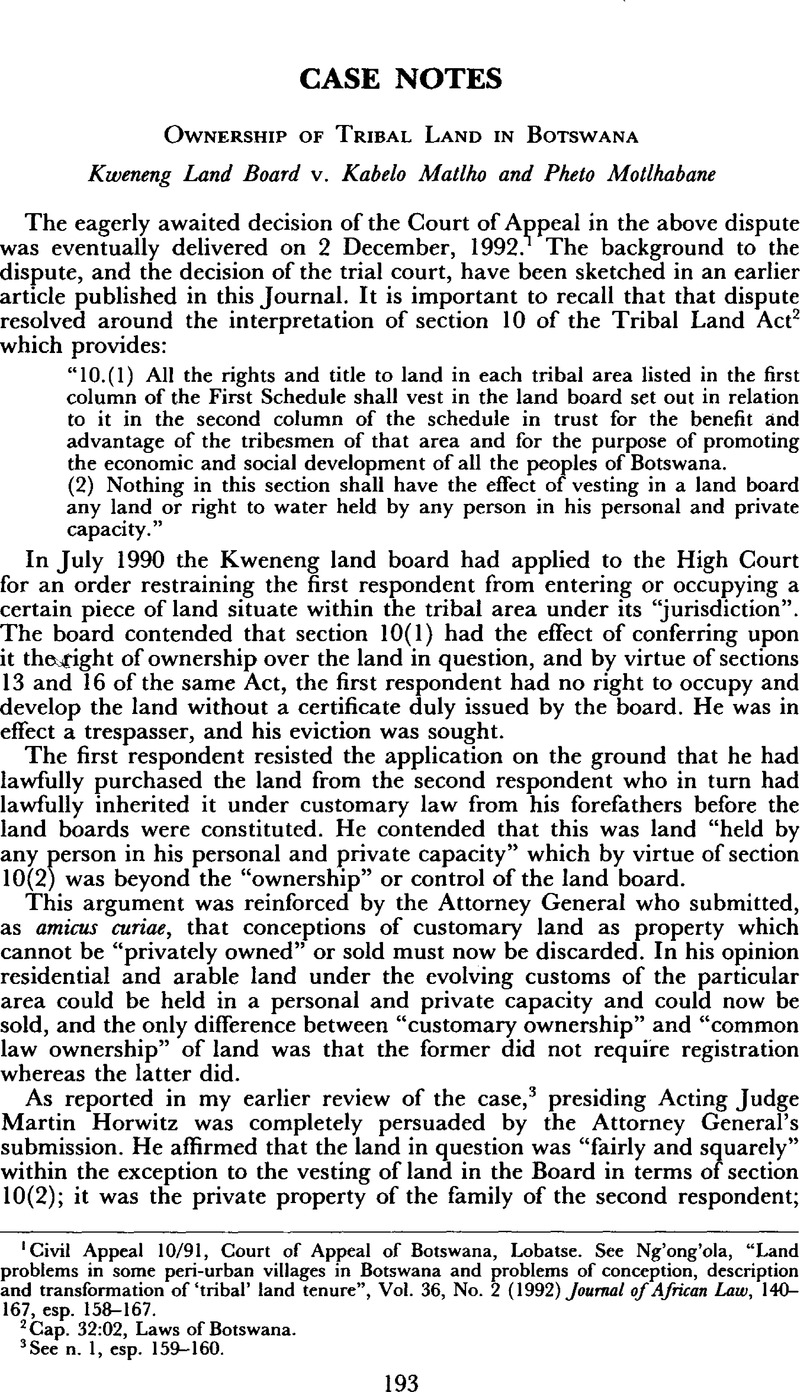Article contents
Ownership of Tribal Land in Botswana: Kweneng Land Board v. Kabelo Matlho and Pheto Motlhabane
Published online by Cambridge University Press: 28 July 2009
Abstract

- Type
- Case Notes
- Information
- Journal of African Law , Volume 37 , Issue 2: LAW AND THE ENVIRONMENT IN AFRICA , Autumn 1993 , pp. 193 - 198
- Copyright
- Copyright © School of Oriental and African Studies 1993
References
1 Civil Appeal 10/91, Court of Appeal of Botswana, Lobatse. See Ng'ong'ola, , “Land problems in some peri-urban villages in Botswana and problems of conception, description and transformation of ‘tribal’ land tenure”, Vol. 36, No. 2 (1992) Journal of African Law, 140–167, esp. 158–167.CrossRefGoogle Scholar
2 Cap. 32:02, Laws of Botswana.
3 See n. 1, esp. 159–160.
4 See Republic of Botswana, Report of the Presidential Commission of Enquiry into Land Problems in Mogoditshane and Other Peri-Urban Villages, Gaborone, 1992, 116, otherwise referred to in the discussion above as the Kgabo Land Commission Report, and Republic of Botswana, “Land problems in Mogoditshane and other peri-urban villages”, Government White Paper No. 1 of 1992, Government Printer, Gaborone, 27.
5 The court here interpreted and applied sections 7(1) and (2) of the Common Law and Customary Law Act, cap. 16:01, Laws of Botswana.
6 These materials included Schapera, I., A Handbook of Tswana Law and Custom, Frank Cass and Co., 1984;Google ScholarMathews, Z. K., “A short history of the Tshidi Barolong”, Fort Hare papers, 1945; and Homan, F. D., “Some aspects of land tenure reform in the tribal territories of Bechuanaland”, Confidential Report to Sir Norman Walker, Governor of Bechuanaland Protectorate, 7 04, 1966.Google Scholar
7 [1921] 2 A.C. 399 at 404–405.
8 P 16 of transcript of Appeal Court judgment.
9 See n. 6.
10 The cases cited, discussed and relied upon on this point included Sigcau v. Sigcau, 1944 A.D. 67, 76; Pillay v. Krishna, 1946 A.D. 951–52; Van Breda v. Jacobs, 1944 A.D. 330, 33; Golden Cape Fruits Ltd. v. Fotoplate Ltd, 1973 (2) S.A. 642, 646; Tropic Plastic and Packaging v. Standard Bank of S.A. Ltd, 1969 (4) S.A. 108, 119; and Barnabos Plein & Co. v. Sol Jacobson and Son, 1928 A.D. 25, 30–31.
11 Pp. 36–37 of the transcript.
12 P. 36 of the transcript.
13 P. 35 of the transcript.
14 The brief was apparently prepared by a Deputy Attorney-General and it is rumoured that several other senior officers in the Attorney-General's Chambers did not agree with the submissions.
15 As Bill No. 7 of 1993, in Botswana Government Gazette Extra-Ordinary dated 24 March, 1993.
16 See for example, the article entitled “Chiefs up in arms against the Land Bill” and the Editorial, in Mmegi/The Reporter, Vol. 10, No. 25, 25 05, 1993, 2–3.Google Scholar
17 The issue attracting most attention appears to be the proposal to make it easier for any citizen of Botswana to acquire tribal land in any area of Botswana. The current reading of the law clearly indicates that this entitlement is reserved for “tribesmen” of the particular tribal area. It would also appear that some chiefs have seized this opportunity to attempt to regain some of their land control powers which were lost to the land boards when this system of tribal land administration was introduced.
18 Article 7(b).
19 Article 8.
20 Article 19, introducing a new section 39 on offences and penalties. The proposed penalties for these various offences are a fine of P10,000, or P20,000 for a corporate body, and imprisonment for one year.
- 2
- Cited by




